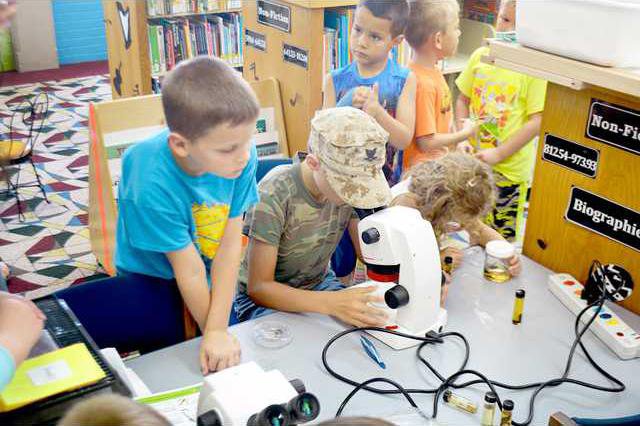The Great Bend Public Library hosted the Kansas Wetlands education Center on Thursday as part of the summer program, “Libraries Rock with Rock and Roll Animals.” KWEC brought in a few animals and taught the children about the different sounds these animals make.
“We are excited to be at the library today and teaching the children what sounds these animals make,” Education Specialist Pam Martin said. “These animals make unique sounds which some of them cannot be heard by the human ear.”
Martin brought in a big brown bat and a screech owl. She explained and demonstrated that these bats produce a variety of vocalizations that are used for navigation, feeding and social communication.
Most vocalizations are pitched well above the range of human hearing and are referred to as ultrasonic. She used a special device for the children called a bat locator in order to be able to hear the high pitched sounds the bats make.
These calls are often known as echolocation calls since bats use the echoes produced when a sound bounces off a bug or a building to determine what is in the area.
“These bats are wonderful creatures. They are very unique on how they communicate with echolocation,” Martin said. “We have to use a special device in order to hear its sounds.”
According to allaboutbirds.org, the screech owl is a unique animal as well. This owl can make 20 different calls which mean a variety of things which include:
• Songs
Both males and females sing. Their most common sounds are an even-pitched trill, often called a “bounce song” or tremolo; and a shrill, descending whinny. The tremolo is used by pairs or families to keep in touch and is 3–6 seconds long. The whinny is 0.5–2 seconds long and is used to defend territories. These two songs may be given one after the other. Mated pairs may sing to each other antiphonally, both day and night.
• Calls
Among the Eastern Screech-Owl’s many calls are soft, low hoots; loud, sharp barking calls that indicate alarm or agitation; and, true to their name, screeches—typically given by adults defending nests or fledglings. A three- or four-note chuckle or rattle denotes annoyance, as when a bird is being mobbed.
• Other sounds
Annoyed screech-owls make a clacking sound by snapping their bill mandibles together. Captured birds may hiss as part of a threat display.
“These animals make certain noises when they are scared and when they are being territorial,” Martin said. “When I reached into the cage to get this owl out, it made a certain noise which meant it was scared and did not know what in going on.”
For more information about the Summer Library Program, call Great Bend Public Library, 620-792-2409.
GBPL host KWEC
Children experience animal sounds





